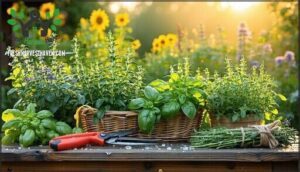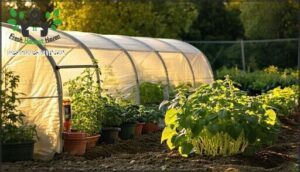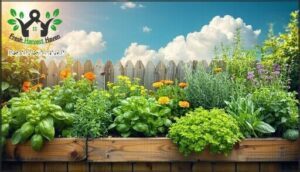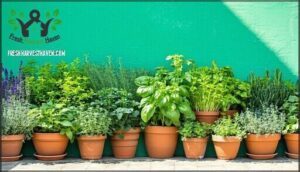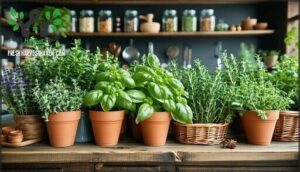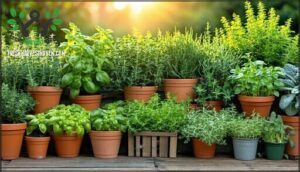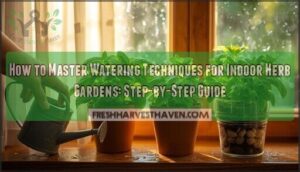This site is supported by our readers. We may earn a commission, at no cost to you, if you purchase through links.

The secret isn’t luck or a greenhouse—it’s understanding how plants respond to water, light, and temperature shifts. Simple strategies like timing your cuts, using row covers, and choosing the right preservation methods transform a three-month harvest into a nearly year-round supply.
Master these extending herb harvest season tips, and you’ll break free from the tyranny of grocery store cilantro that tastes like soap.
Table Of Contents
Key Takeaways
- You can extend your herb harvest by eight weeks or more through strategic timing of cuts, using row covers for frost protection, and choosing appropriate preservation methods like freezing or drying.
- Healthy harvest starts before you cut anything—water plants thoroughly the night before harvesting, maintain well-drained soil over rich fertility, and ensure herbs get 4-6 hours of daily sunlight for peak flavor.
- Regular clipping every two weeks for annuals and every four-to-six weeks for perennials prevents flowering and triggers branching, effectively doubling your yield by keeping plants in vegetative growth mode.
- Season extenders like cold frames, raised beds, and high tunnels can push your growing window weeks earlier in spring and later in fall, with raised beds warming soil 5-10°F faster than ground-level plots.
Preparing Herbs for Extended Harvests
You won’t get extended harvests without healthy plants to begin with. Before you even think about cold frames or fancy preservation methods, you need to nail the basics—watering, soil quality, and sunlight.
Here’s what your herbs need to thrive through a longer season.
Watering and Stress Management Before Harvest
Before you snip a single stem, make sure your herbs are fully hydrated—stressed plants won’t give you the bold flavors you’re after. This pre-harvest care step is non-negotiable for serious herb gardening success.
Water your herb garden thoroughly the night before harvest timing to maximize plant hydration and soil moisture levels.
Here’s your watering checklist:
- Check soil moisture by inserting your finger two inches deep—it should feel consistently damp
- Water deeply in the evening to allow full absorption before morning harvesting herbs
- Avoid water stress by maintaining regular irrigation during dry spells
- Never harvest from wilted or drought-stressed plants, as harvest management depends on peak vitality
Ideal Soil Conditions and Sunlight Needs
Your herbs won’t reach their flavor potential if you stick them in the wrong soil or leave them starving for sunlight. Aim for 4-6 sunlight hours daily—that’s your baseline for vigorous herb gardening success.
Soil drainage matters more than soil fertility here; well-drained beds with low-to-medium nutrients actually intensify flavor, while overly rich soil creates bland, leafy growth. Skip heavy fertilizer needs and focus on soil preparation and maintenance that prevents waterlogging—your drainage systems determine whether your plants thrive or drown.
Essential Tools and Harvest Preparation Steps
Grab your sharp clippers, a sturdy container, and garden gloves—these three simple tools turn you from a casual herb enthusiast into a precision harvester.
Before you start clipping, water your plants thoroughly the night before; hydrated herbs deliver maximum flavor and tolerate the stress of pruning shears better than thirsty ones, setting you up for successful harvest preparation.
Best Techniques for Harvesting Herbs
You’ve prepped your herbs—now it’s time to actually cut them. The way you harvest makes a huge difference in how much you’ll get and how healthy your plants stay.
Here’s how to do it right, whether you’re working with perennials or annuals.
Harvesting Perennial Vs. Annual Herbs
Not all herbs play by the same rules—perennials like oregano and sage are the forgiving workhorses of the garden, while annuals such as basil demand a bit more attention to keep them producing all season long.
With perennial herb care, you can cut back one-third to one-half of the plant anytime during the growing season without breaking a sweat.
Annual harvest tips center on regular clipping to prevent flowering—once they seed, production crashes. Keep your shears sharp and stay ahead of those blooms for maximum herb regrowth.
Timing and Frequency for Optimal Yield
Harvest too early and you’ll leave flavor on the table—wait too long, and your herbs shift from growth mode to seed production before you’ve filled your basket. Harvest schedules built around growth cycles keep your yield optimization on track:
- Perennials: Cut at four-to-six-week harvest intervals throughout summer harvest season
- Annuals: Clip every two weeks during active herb cultivation to prevent flowering
- Peak flavor: Harvest mid-morning after dew dries but before afternoon heat
These harvesting techniques align with natural crop rotation patterns for maximum harvest optimization.
Promoting Growth Through Regular Clipping
Every snip you make triggers a biological alarm in your herb plant—one that forces it to branch, bulk up, and churn out fresh foliage instead of channeling energy into seeds. That’s the real power of herb pruning—you’re hacking growth patterns to double your yield.
Regular clipping benefits go beyond harvest; you’re training plants through foliage management. These harvesting techniques transform gardening tips into regrowth mastery, giving you control over herb cultivation season after season.
Extending The Growing Season Outdoors
You don’t have to let frost dictate when your herb garden shuts down for the year. A few simple structures can push your growing window weeks earlier in spring and weeks later in fall.
Here’s what works to keep your plants productive when nature says otherwise.
Using Cold Frames, Row Covers, and High Tunnels
When frost threatens to cut your harvest short, season extenders become your secret weapon for squeezing weeks of extra growth from your herb garden. Cold frames deliver consistent frost protection methods and trap solar heat, while lightweight row cover materials offer 2°F protection—upgrade to heavyweight options for 10°F defense.
High tunnel designs create microclimates that push your harvest management two to four weeks beyond normal limits in both spring and fall.
Raised Beds for Early and Late Harvests
Raised beds act like thermal batteries for your soil, warming faster than ground-level plots and letting you transplant herbs several weeks ahead of schedule. Here’s how bed construction pays off:
- Soil temperature rises 5–10°F warmer in spring, giving you an early start
- Crop rotation becomes simpler with defined herb garden spaces
- Late harvest extends as beds retain warmth through fall frosts
Elevated beds drain better and warm quicker—your ticket to stretched seasons.
Maximizing Growing Days in Different Regions
Your region’s frost-free period determines which herbs thrive and when. Northern gardeners with 90–150 days should focus on hardy perennials like thyme and cold-season annuals such as cilantro, while southern growers with 229+ days can harvest heat-loving basil and oregano year-round.
Regional climate demands smart frost protection—use microclimates near south-facing walls to add 2–3 weeks of harvest optimization, and adjust temperature management strategies based on local patterns for enhanced herb cultivation techniques. Understanding the essential temperature fluctuations is vital for a successful herb harvest.
Preserving and Storing Herbs for Longevity
You’ve stretched your growing season—now it’s time to lock in that harvest. Preserving your herbs correctly means you won’t lose flavor, potency, or those hard-won nutrients.
Here are three proven methods to keep your herbs at their peak long after the frost hits.
Air Drying, Tray Drying, and Alternative Methods
You’ve got the power to lock in flavor and potency through smart herb preservation methods. Air drying works best when humidity stays below 60% with air velocity around 0.5 m/s.
Here are proven drying techniques:
- Air drying herbs on absorbent towels for 6-8 days, fluffing daily to prevent mold
- Tray drying at 40-60°C efficiently processes mint in 240-390 minutes to ideal moisture levels
- Dehydrator drying herbs at 55-60°C maximizes essential oil yield without volatile compound loss
- Freeze drying delivers peerless retention of bioactive compounds and shelf stability
To preserve herbs effectively, understanding herb drying methods is vital for maintaining their flavor and aroma.
Freezing Herbs for Maximum Nutrient Retention
Freezing your herbs at peak harvest locks in up to 90% more nutrients than dried alternatives—and it’s ridiculously simple. Flash freezing basil, cilantro, or parsley within hours of harvesting herbs prevents enzymatic degradation. Try frozen herb cubes—blend chopped herbs with oil, freeze in trays—for instant flavor bombs.
| Method | Best For |
|---|---|
| Flash freezing | Delicate leaves (basil, dill) |
| Herb blending with oil | Cooking applications |
| Ice harvesting (whole stems) | Visual appeal, garnishes |
| Frozen herb cubes | Soups, sauces, marinades |
Nutrient preservation through freezing herbs beats drying every time for herb storage that delivers.
Proper Storage to Maintain Flavor and Quality
Once you’ve frozen your herbs, the real key is storing them right—because even frozen gold loses its shine in a frost-burned container. Use airtight containers or vacuum-sealed bags for proper herb storage—moisture control is everything. Label and date your stash; frozen herbs maintain peak flavor preservation for 6–12 months.
For storing dried herbs, dark glass jars away from heat extend shelf life dramatically, keeping your drying herbs potent through winter’s end.
Maintaining Healthy Herb Plants Year-Round
Your harvest doesn’t end when you clip the last stem. Keeping your herbs vigorous between harvests means they’ll keep producing for you, season after season.
Here’s how to maintain plants that deliver consistent yields and resist going to seed when you need them most.
Pruning, Pinching, and Cleanup After Harvest
After you’ve filled your basket with fresh-cut herbs, don’t just walk away—a little post-harvest care will keep your plants pumping out flavorful leaves all season long. Here’s your quick foliar maintenance routine:
- Remove damaged stems using sharp pruning tools
- Pinch back leggy growth to trigger branching
- Clear fallen leaves from soil to prevent disease
- Shape plants for easier future access
These regrowth techniques transform harvest cleanup into strategic pruning that fuels continuous production.
Monitoring Flowering and Preventing Seed Formation
Your cleanup work naturally leads to the next defensive play: spotting flower buds before they rob your harvest. Watch for these flowering signals and act fast.
| Control Method | Action | Result |
|---|---|---|
| Flower Monitoring | Inspect growing tips weekly | Catch buds before seed formation starts |
| Environmental Control | Apply mulch to keep soil under 25°C | Delays bolting in parsley and cilantro |
| Hormone Regulation | Use high-nitrogen, low-phosphorus feed | Suppresses reproductive shift, extends leaf production |
Removing flower buds the moment they appear keeps your herbs in vegetative mode, preventing seed formation that ends your harvest window. Regular herb harvesting doubles as seed prevention—you’re literally clipping off the growing tips destined to become flowers.
These phenology models prove what growers have known for years: flower harvesting isn’t optional if you want maximum yields from seed producers like basil and dill.
Dividing and Propagating Perennial Herbs
Early spring dividing turns one tired perennial into three vigorous plants, giving you triple the harvest without spending a dime. Here’s your propagation playbook for perennial herb division:
- Dig around oregano, thyme, or sage crowns when soil warms to 10°C, exposing root systems ready for separation.
- Pull apart root clumps by hand or slice with clean shears, confirming each division carries 3-4 healthy shoots.
- Replant divisions immediately in well-drained soil, spacing 30cm apart for unrestricted regrowth.
- Harden off new plants with gradual sun exposure over 7-10 days, building resilience before full transplant.
These propagation methods deliver a continuous supply from your herb garden all season.
Frequently Asked Questions (FAQs)
Can I grow herbs indoors during winter months?
Yes, you can bring herb gardening indoors during winter with proper indoor lighting and climate control. Choose compact herbs like basil or thyme for indoor pots, guaranteeing sufficient light and warmth to keep your herb garden thriving year-round.
Which herbs are most cold-hardy for fall harvesting?
Parsley, thyme, and sage are your fall champions—they laugh at light frosts. Chives, oregano, and rosemary also tolerate cold like pros, giving you fresh flavors well into November.
How do I protect herbs from early frost?
Don’t let Jack Frost crash your herb party uninvited. Deploy lightweight row covers for 2°F frost protection or heavyweight versions offering up to 10°F freeze prevention.
Cold frames and high tunnels shield tender plants, while proper winter care—like mulching roots—keeps your herb garden maintenance on point through unpredictable weather.
What pests commonly affect herbs in extended seasons?
Cool-season pests like aphids and whiteflies thrive in protected herb environments. Aphid control requires regular monitoring, while whitefly management and fungal diseases demand proper ventilation.
Insect traps and pest prevention through seasonal herb care keep your gardening techniques effective year-round.
Should I fertilize herbs during season extension periods?
Most herbs thrive with low to medium fertility levels, so skip fertilizer during season extension periods. Organic supplements might reduce flavor intensity in your herb garden.
Focus on well-drained soil pH and nutrient balance instead—stressed plants from high fertility produce less aromatic leaves for herb harvesting and preservation.
Conclusion
Think of your herb garden as a marathon, not a sprint—you’re not racing to the finish line in July. By applying these extending herb harvest season tips, you’ll coax fresh flavor from your plants long after your neighbors have thrown in the trowel.
Protection, pruning, and preservation aren’t chores; they’re your backstage pass to culinary freedom. So break the cycle of bland winter cooking, and keep your kitchen stocked with herbs that actually taste like something.

